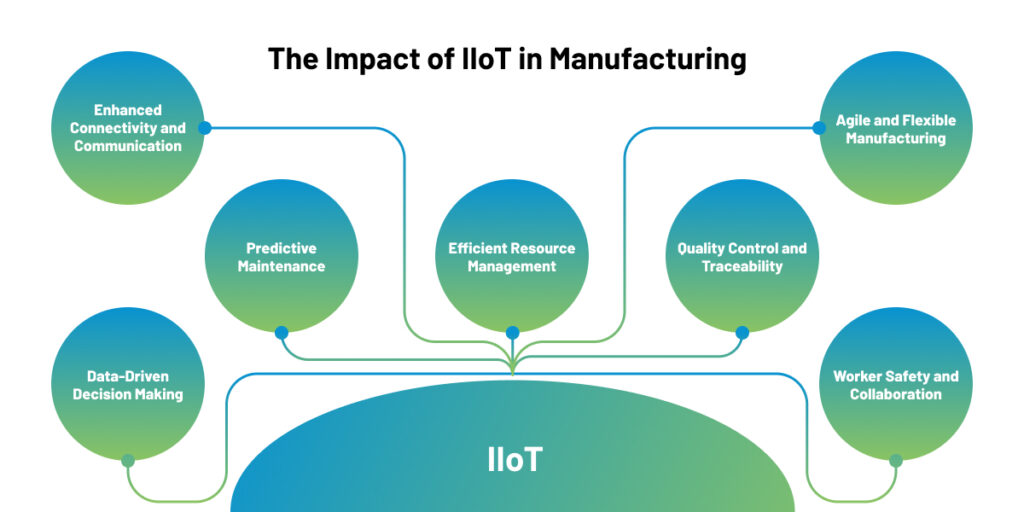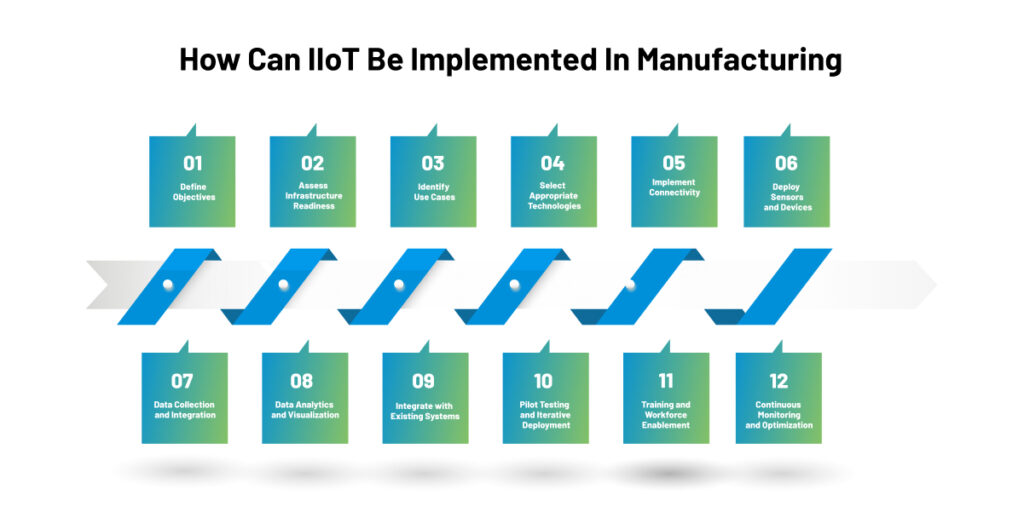The landscape of modern manufacturing has witnessed a significant transformation in recent years. At the forefront of this revolution is the emergence of the Industrial Internet of Things (IIoT). With its ability to connect machines, devices, and systems seamlessly, IIoT has become a game-changer, revolutionizing the way factories operate and opening up new realms of possibility for manufacturers worldwide.
Gone are the days of traditional manufacturing processes, where manual labor and isolated machinery were the norm. With the integration of the Industrial Internet of Things, the manufacturing sector is experiencing an unprecedented wave of connectivity, intelligence, and efficiency. By interconnecting various components of the production line, IIoT is enhancing productivity, streamlining operations, and redefining the very essence of modern manufacturing.
This blog post explores the profound impact of IIoT on modern manufacturing. We will explore how IIoT revolutionizes the industry, empowering manufacturers to achieve higher efficiency, quality, and agility levels. Let’s get started.
Introduction to IIoT in Manufacturing
The Industrial Internet of Things (IIoT) represents a groundbreaking technological advancement that has the potential to revolutionize modern manufacturing. At its core, IIoT involves the integration of physical devices, machinery, and systems within industrial environments, enabling them to communicate, exchange data, and operate collaboratively.
Unlike traditional manufacturing setups, where machines function in isolation or with limited connectivity, IIoT fosters a highly interconnected ecosystem. By leveraging sensors, actuators, and advanced communication technologies, IIoT enables the seamless exchange of real-time information between various production line components.
This interconnectedness brings forth a host of advantages for manufacturers. First and foremost, IIoT enhances operational efficiency by providing comprehensive visibility into the manufacturing process. Real-time data collection and analysis empower decision-makers to gain insights and optimize operations, improving productivity and reducing downtime.
Additionally, IIoT enables predictive maintenance, a significant departure from reactive or scheduled maintenance practices. By continuously monitoring the condition and performance of machines, IIoT systems can detect anomalies, identify potential issues, and schedule maintenance activities proactively. This predictive approach helps manufacturers avoid costly breakdowns, optimize maintenance schedules, and extend the lifespan of their equipment.
Furthermore, the Industrial Internet of Things facilitates the implementation of intelligent automation and robotics. By integrating sensors and actuators with automated systems, manufacturers can achieve higher precision, accuracy, and consistency in their production processes. This reduces human error and enables the implementation of complex tasks that were previously unattainable without human intervention.
The impact of IIoT extends beyond the factory floor. It plays a vital role in supply chain management, enabling real-time inventory tracking, enhanced logistics, and improved coordination between suppliers, manufacturers, and distributors. This heightened visibility ensures seamless operations, reduced delays, and greater customer satisfaction.
In summary, the significance of IIoT in modern manufacturing cannot be overstated. Its ability to interconnect devices, collect and analyze data, and enable intelligent decision-making has transformed the industry. By harnessing the power of IIoT, manufacturers can achieve increased productivity, reduced costs, enhanced quality, and improved sustainability, thereby staying competitive in the fast-paced, technology-driven manufacturing world. To understand better, let’s look at the benefits of IIoT in manufacturing.
Also, Read – The Future of Work in Industry 4.0: How Automation and AI are Reshaping Manufacturing Jobs
The Impact of IIoT on Manufacturing
The Industrial Internet of Things (IIoT) is revolutionizing the manufacturing industry by integrating physical devices, machines, and data networks into a cohesive ecosystem. It enables the collection, analysis, and utilization of vast amounts of real-time data, significantly improving productivity, efficiency, and overall operational performance. Here are seven well-defined points that elaborate on how IIoT is changing the face of modern manufacturing:

- Enhanced Connectivity and Communication
IIoT provides a robust network infrastructure that connects various devices and systems within a manufacturing environment. This connectivity allows seamless communication and data exchange between machines, sensors, production lines, and manufacturing facilities. The improved connectivity facilitates real-time monitoring, remote control, and coordination of manufacturing operations, enabling faster decision-making and response times.
- Predictive Maintenance
One of the critical advantages of IIoT in manufacturing is the implementation of predictive maintenance strategies. By leveraging sensor data, machine learning algorithms, and real-time analytics, IIoT enables manufacturers to monitor equipment’s health and performance and accurately predict maintenance needs. This proactive approach to maintenance helps prevent unexpected breakdowns, reduces downtime, optimizes maintenance schedules, and extends the lifespan of critical assets.
- Efficient Resource Management
The Industrial Internet of Things enables manufacturers to optimize resource allocation and utilization. By gathering data on energy consumption, raw material usage, and equipment performance, companies can identify inefficiencies and implement energy-saving measures and process improvements. Real-time resource usage monitoring and analysis also help identify bottlenecks and optimize production workflows, reducing waste and increasing operational efficiency.
- Quality Control and Traceability
IIoT is crucial in ensuring product quality and traceability throughout the manufacturing process. Sensors embedded in production lines collect data on various parameters such as temperature, pressure, and humidity, enabling real-time monitoring and quality control. Furthermore, IIoT facilitates supply chain data integration, allowing manufacturers to track and trace products from raw material sourcing to the end customer. This traceability helps promptly identify and rectify quality issues, improving customer satisfaction and reducing recalls.
- Agile and Flexible Manufacturing
IIoT empowers manufacturers to embrace agile and flexible production methodologies. IIoT enables seamless collaboration and coordination between manufacturing stages and work cells by connecting machines and systems. This connectivity enables the implementation of real-time production adjustments, such as dynamic scheduling, reconfigurable production lines, and rapid changeovers. As a result, manufacturers can respond quickly to changing customer demands, reduce time to market, and efficiently handle customization requests.
- Data-Driven Decision Making
With the proliferation of IIoT devices and systems, manufacturers have access to a wealth of real-time data. Companies can extract valuable insights from this data and make data-driven decisions using advanced analytics and artificial intelligence techniques. These insights can range from identifying production bottlenecks and optimizing supply chain operations to predicting customer demand and improving product design. Data-driven decision-making based on IIoT data leads to better operational efficiency, cost savings, and increased competitiveness.
- Worker Safety and Collaboration
IIoT technologies contribute to improving worker safety and collaboration in the manufacturing industry. Wearable sensors can monitor workers’ vital signs and movements, alerting them to potential hazards and providing immediate assistance in emergencies. The Industrial Internet of Things enables seamless collaboration between workers and machines, promoting human-machine partnerships. With real-time data and augmented reality interfaces, workers can access valuable information, instructions, and remote expert assistance, increasing productivity and safety.
In summary, the Industrial Internet of Things (IIoT) revolutionizes modern manufacturing, bringing unprecedented connectivity, efficiency, and agility. From enhanced communication and predictive maintenance to resource optimization and data-driven decision-making, the impact of IIoT on the industry is undeniable.
However, as we delve deeper into the potential of IIoT, let’s explore practical ways to implement this transformative technology in manufacturing.
How Can IIoT Be Implemented In Manufacturing
Implementing Industrial IoT (IIoT) in manufacturing requires careful planning and execution. Here are the key steps to consider when implementing IIoT in manufacturing:

Define Objectives: Define the objectives and goals you want to achieve with IIoT implementation. Identify the areas where IIoT can bring the most value, such as improving operational efficiency, optimizing maintenance processes, enhancing quality control, or enabling real-time monitoring and decision-making.
Assess Infrastructure Readiness: Evaluate your existing infrastructure and determine its readiness for IIoT implementation. Ensure a robust network infrastructure handles increased data traffic and supports seamless device connectivity. Assess the availability of necessary hardware, such as sensors, actuators, gateways, and data storage systems.
Identify Use Cases: Identify specific use cases where the Industrial Internet of Things can significantly impact your manufacturing processes. This could include real-time monitoring of equipment, predictive maintenance, remote diagnostics, energy management, inventory tracking, or supply chain optimization. Prioritize use cases based on their potential value, feasibility, and return on investment.
Select Appropriate Technologies: Select the right IIoT technologies and platforms that align with your use cases and requirements. Consider factors such as connectivity options (e.g., Wi-Fi, Ethernet, cellular), compatibility with existing systems (e.g., SCADA, MES), data storage and analytics capabilities, and scalability. Choose vendors or partners with a proven track record in IIoT solutions.
Implement Connectivity: Establish a reliable and secure network infrastructure to enable connectivity between devices and systems. This may involve setting up wireless networks, deploying gateways for protocol translation, and ensuring seamless integration with existing IT infrastructure. Implement appropriate security measures, such as firewalls, VPNs, and encryption, to protect data transmission and prevent unauthorized access.
Deploy Sensors and Devices: Deploy sensors and devices strategically to collect relevant data from machines, equipment, and other manufacturing assets. Ensure that these devices are compatible with your chosen IIoT platform and capable of providing accurate and reliable data. Consider sensor placement, power supply, environmental conditions, and maintenance requirements.
Data Collection and Integration: Establish mechanisms for collecting, aggregating, and integrating data from various sources. This may involve integrating data from sensors, machines, ERP systems, or external sources such as weather forecasts or market demand data. Leverage edge computing capabilities to process data locally and minimize latency in real-time applications.
Data Analytics and Visualization: Implement data analytics tools and algorithms to extract meaningful insights from the collected data. Utilize machine learning and artificial intelligence techniques to identify patterns, anomalies, and trends that can inform decision-making and drive process improvements. Visualize data through dashboards, reports, or mobile applications to provide actionable information to relevant stakeholders.
Integrate with Existing Systems: Ensure seamless integration of IIoT systems with existing manufacturing systems, such as SCADA, MES, ERP, or CMMS. Establish data exchange protocols and APIs to enable bi-directional communication and data sharing between IIoT platforms and legacy systems. This integration allows for better coordination, workflow automation, and data-driven decision-making across the organization.
Pilot Testing and Iterative Deployment: Start with a pilot implementation in a controlled environment to validate the effectiveness of the IIoT solution. Measure key performance indicators (KPIs) related to your objectives and use cases. Gather feedback from users and stakeholders, and iterate on the solution based on lessons learned and user insights. Scale up the implementation gradually to other areas of the manufacturing process.
Training and Workforce Enablement: Provide adequate training and education to the workforce to ensure they understand the benefits and functionality of IIoT systems. Empower employees to utilize IIoT data and insights for improved decision-making and problem-solving. Foster a continuous learning and innovation culture to maximize the value derived from IIoT implementation.
Continuous Monitoring and Optimization: Establish a process for monitoring, maintaining, and optimizing IIoT systems. Regularly assess the performance of sensors, devices, and connectivity infrastructure. Monitor data quality and integrity to ensure reliable insights.
Following these steps, leaders can effectively implement IIoT in manufacturing and leverage its transformative capabilities to drive operational excellence, improve productivity, and gain a competitive advantage in the modern industrial landscape.
Also, Read – Smart Manufacturing Trends 2023-24
Wrapping It Up!
As the Industrial Internet of Things (IIoT) continues to reshape the landscape of modern manufacturing, the possibilities for innovation and efficiency are boundless. By connecting industrial devices, gathering valuable data, and enabling real-time analysis, IIoT has become a catalyst for transformation across the manufacturing sector.
Looking ahead, the future of IIoT in manufacturing holds great promise. Advancements in technologies such as edge computing, 5G connectivity, and digital twins will further enhance the capabilities of IIoT systems, enabling even faster and more intelligent decision-making. The convergence of IIoT with artificial intelligence, machine learning, and predictive analytics will drive automation to new heights, optimizing processes and reducing costs.
Additionally, IIoT will be pivotal in enabling agile and resilient supply chains. Real-time visibility into inventory levels, demand patterns, and logistics will empower manufacturers to adapt swiftly to changing market dynamics, reduce waste, and improve customer satisfaction. The seamless integration of Industrial Internet of Things systems with suppliers and customers will foster collaboration, enabling seamless coordination and synchronization of manufacturing processes.
However, as IIoT proliferates, it is crucial to address the challenges it brings, particularly in terms of cybersecurity. Manufacturers must prioritize robust cybersecurity measures, from network segmentation to encryption and authentication, to safeguard against potential cyber threats. With proactive measures and ongoing investment in security, the full potential of IIoT can be realized without compromising the integrity and confidentiality of sensitive data.
Ultimately, the widespread adoption of IIoT in manufacturing holds immense potential for creating a more innovative, efficient, and interconnected ecosystem. It will drive operational excellence, enhance product quality, optimize supply chains, and contribute to safer work environments. Embracing IIoT is not merely an option but a necessity for manufacturers seeking to stay competitive in the rapidly evolving digital era.
As we venture into this exciting future, manufacturers must remain agile, adaptable, and open to embracing technological advancements. By seeking digital transformation consultants to help leverage the power of IIoT, manufacturers can unlock unprecedented levels of productivity, efficiency, and innovation. The journey toward smart manufacturing powered by IIoT has just begun, and the possibilities are limitless. So, embrace this transformative technology and seize the opportunities it presents to shape the future of modern manufacturing.




